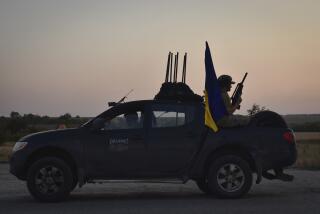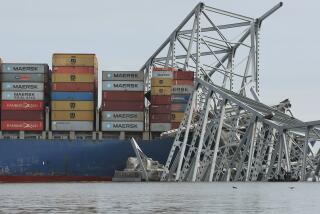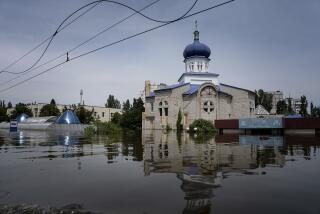U.S. Readying Its Bridges for River in Iraq
- Share via
WASHINGTON — The Pentagon is outfitting Army engineering units with state-of-the-art river-crossing equipment capable of moving large numbers of troops and heavy materiel across the Euphrates quickly if the decision is made to attack Iraq, current and former defense officials say.
The portable bridges -- carried on truck beds in retractable sections that snap out into flat spans when they hit the water -- are being delivered to some of the dozen or so units at U.S. and European bases that might deploy to the Persian Gulf in the event of war.
Any U.S. military drive to oust Iraqi President Saddam Hussein from power probably would require not just airstrikes but also a full-scale ground attack.
Military officials say it would be impossible to control Iraq without crossing the broad Euphrates, which flows the length of the country and passes near Baghdad. The rapidly deployed bridges could play a crucial role, minimizing U.S. casualties by speeding large numbers of soldiers and heavy equipment across the river.
No matter how U.S. troops were to advance across Iraq, they would face the task of bridging and controlling the strategic waterway.
“At the end of the day, there will have to be equipment moved across the Euphrates, because if you want to control Iraq, you have to have forces on both sides of that river,” said retired Lt. Gen. James Terry Scott, former commander of the Army’s Special Operations Command. “And it will have to be over something that we can construct, because Iraq just doesn’t have big enough existing bridges to move that kind of heavy equipment. And if it does, Saddam Hussein is going to make sure they get blown up.”
Units that specialize in the muddy, difficult work of a major river crossing recently have stepped up training. In September, the Army’s armor-heavy 1st Cavalry Division, based at Ft. Hood, Texas, conducted a huge exercise to practice the procedure. Military officials say the unit most likely would be the first deployed in any invasion of Iraq.
Other units are following suit, honing their skills at a task that was considered an important capability in Cold War days, when the military needed to be ready to cross the many rivers of Europe with ease.
Since the end of the Cold War, the focus of U.S. military operations has shifted from Europe to areas of the globe with fewer broad rivers, and the technique of fighting has shifted from the deployment of massive ground forces to heavy reliance on air power, making river crossing less important.
In the 1991 Persian Gulf War, U.S. forces had no need to cross the Euphrates because their goal was simply to expel Iraq from occupied Kuwait. This time, however, the stated aim is ousting Hussein from power and changing the Iraqi regime -- a task likely to require entry into Baghdad.
Military history is replete with tales of crucial and treacherous river operations, from Washington crossing the Delaware to the U.S. 3rd Army’s rush over the Rhine in 1945, but American forces have not faced enemy fire while crossing a major river with a large force in five decades.
“At that point, Iraq has a half-mile-wide moat that the American Army is going to have to get across,” said John Pike, director of GlobalSecurity.org, a military research firm. “If there’s one place that the Republican Guard might counterattack, that would be it.”
Even if the U.S. military were to face no enemy at the banks of the Euphrates, it would have a complex logistical challenge on its hands.
The last time U.S. ground forces crossed a major river under conditions that might have led to combat was in Bosnia-Herzegovina in 1995.
That crossing of the Sava River was unopposed. But it was severely complicated by the worst flooding on the river in 70 years, at the height of the harsh Balkan winter. Few commanders involved had executed a major river operation, even in training, said retired Army Maj. Gen. William Nash, who commanded U.S. ground forces in Bosnia at the time.
Even so, U.S. forces were so confident about the operation that they ferried troops and equipment across in helicopters and rafts long before the bridge was completed. After almost a week of attempts, Army engineering brigades built a 373-foot one-lane span in 72 hours. During the next few weeks, it was expanded to allow two-way traffic; 20,000 vehicles, many of them heavy fuel tankers and artillery pieces, crossed over it safely.
The last time U.S. forces faced an enemy while crossing a river of any size was during the 1950-53 Korean War, at the Han River. In World War II, the 3rd Army under Gen. George S. Patton Jr. used some of the techniques still employed today to cross the Rhine.
“Unlike the situation that faced Washington crossing the Delaware, Robert E. Lee and Patton, for that matter, we’ve got a capacity today, with our air and mobile capacities, that allows us to jump that river with a lot less vulnerability to the forces doing the crossing,” Nash said. “But you’ve still got to move a lot of things across that river that can’t fly.”
Military planners at the Pentagon are analyzing a broad range of options for an invasion of Iraq, but all call for advancing significant ground forces deep into the country and for crossing the wide, slow-moving expanse of the Euphrates to take control of nearby Baghdad, defense officials said. Several plans also call for crossing the Tigris, the other major river that slices across Iraq.
“This is one of the contingencies that has to be addressed, and that planners are addressing,” said a defense official, speaking on condition of anonymity. “It’s pretty simple. If what we need to do is on the other side, we have to cross that river.”
Getting an armored force, even a relatively light force, across a river is anything but simple. Although every ground unit is trained and outfitted to get troops and equipment across small rivers, creeks and gaps, crossing a major river is a different challenge altogether.
Although many aspects of waging war have gotten easier with the advent of modern technology, crossing a river has in some respects become harder, because a modern army has so much equipment to move.
And although technology has made it possible for the modern army to protect crossers with air power as it unfurls bridges off the backs of trucks, the fundamentals of attacking an enemy across a river have not changed since ancient times, when the Persian army built bridges in the 5th century BC during its invasion of Greece, and ancient Macedonia, a century later, first used professional engineers to speed a river crossing.
Any U.S. ground force driving to Baghdad would number 2,000 vehicles at a bare minimum, according to former military officials with experience in such crossings.
Before a bridge could be constructed, ground forces would have to get the structure and the necessary heavy equipment -- including rafts and small boats -- to the river. Once there, warplanes and combat helicopters would protect the bridge-building operation. Troops and light equipment would be ferried across the river on helicopters and rafts to secure the other side.
Although military planners think it unlikely that Hussein’s army would be capable of mounting any significant opposition at the banks of the Euphrates or the Tigris, the Iraqis could do some mischief, the planners say.
If the Army slowed while crossing the river, that could give the enemy a chance to lob artillery shells at the Americans. Iraqi combat engineers, considered among their nation’s most competent soldiers, also could dynamite standing bridges over the Euphrates, making crossing with even light ground forces significantly more difficult.
If Hussein chose to launch a chemical or biological attack against invading U.S. forces, the banks of the Euphrates could give him the chance to do so while the American military had a large number of troops and equipment in one place. There are also major dams along both the Tigris and the Euphrates that the Iraqis could open to swell the rivers.
During the past decade, the U.S. Army has reduced the number of units trained to cross major rivers.
Currently, there are six such units at the division level, according to Russell Glenn, a senior defense analyst at Rand, a Santa Monica-based think tank, who as an Army officer commanded an infantry division’s bridge company in the 1970s.
The bridge units are attached to mechanized and armored divisions. Two are based at Ft. Hood and one at Ft. Stewart in Georgia. Two more are based in Germany and another in South Korea.
The Army also has reserve units trained to get personnel and equipment across rivers and already has positioned in the Gulf region some of the bridges, trucks and other heavy equipment that would be needed for crossing the Euphrates.
Three of the divisions will finish regularly scheduled training by the end of this year that would ready them for an assault on Iraq in January or February.
The new bridge being deployed to the units, the Improved Float Bridge (Ribbon Bridge), is carried on a modified Army truck chassis. The Pentagon began deploying the equipment in June 2001.
The bridge, produced by a German company, is a significant improvement over earlier ribbon bridges, according to Glenn. Copied in Cold War days from satellite photos of Soviet ribbon bridges, plus one captured by the Israelis from the Egyptians, it is made up of several sections. Some of the sections have ramps and supports to secure the structure against steep riverbanks; others are designed to attach to the end sections and float on pontoons in the middle of a river.
At the touch of a series of controls, the bridge sections slide off the back of the truck and flatten out as they hit the water. When they are deployed, tug-like boats -- also brought to the banks of a river on trucks -- push the sections together. Soldiers then secure them to each other.
The new bridge supports more weight than earlier versions and can be secured to steeper riverbanks. The bridge also stays more stable in faster currents than earlier models. With modern military mobile artillery pieces weighing in at as much as 140,000 pounds, such improvements become critical, according to military analysts.
“River crossings are technically difficult feats of amazing technology and skill,” Glenn said. “To get vast amounts of heavy equipment across a major river, you can’t bring it in by air; you have to worry about currents, muddy banks, steepness of the banks, depth of the water. It’s never been easy.”
More to Read
Sign up for Essential California
The most important California stories and recommendations in your inbox every morning.
You may occasionally receive promotional content from the Los Angeles Times.













